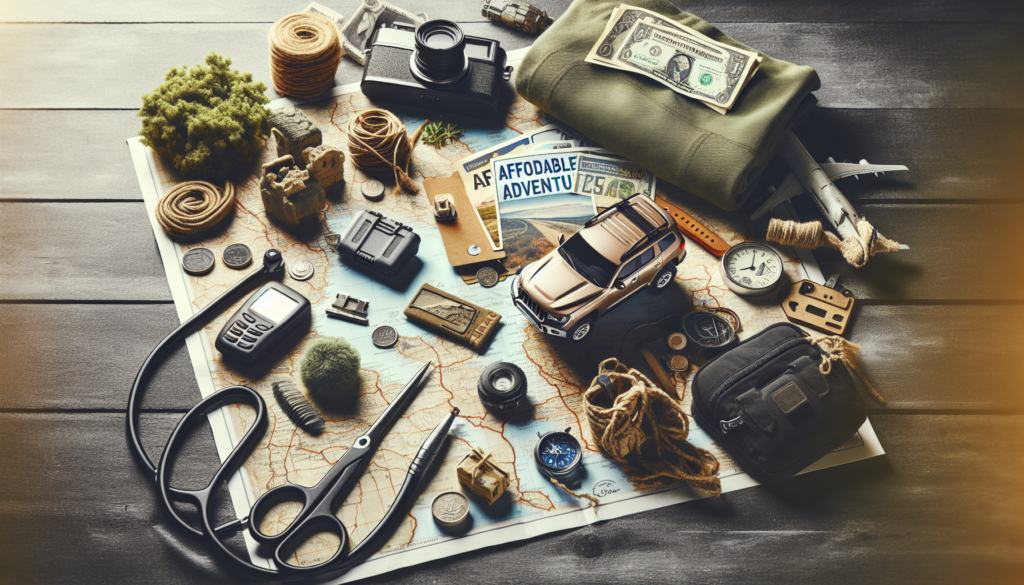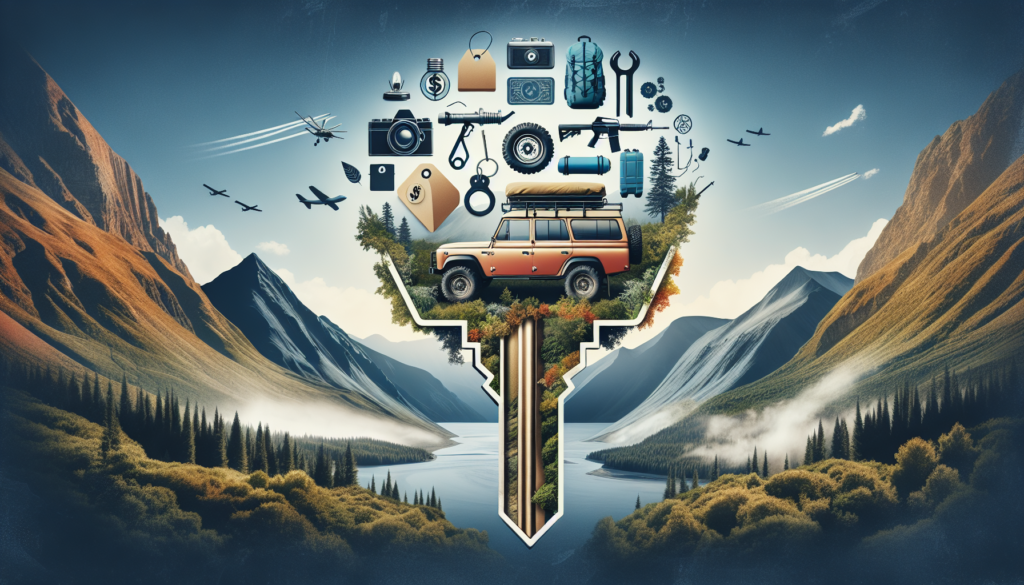So, you’re interested in embarking on an overlanding adventure, but you’re wondering what kind of budget you’ll need to make it happen. Well, you’ve come to the right place! In this article, we will explore the key factors that contribute to the overall cost of overlanding, including accommodations, transportation, food, and activities. Whether you dream of traversing rugged terrain in a camper van or camping under the stars, we’ve got you covered with essential tips and insights to help you plan your budget for the ultimate overlanding experience. Get ready to hit the road without breaking the bank!
Choosing a Vehicle
Considerations for vehicle purchase
When it comes to choosing a vehicle for your overlanding adventures, there are several key considerations to keep in mind. First and foremost, you’ll want to think about the type of terrain you’ll be tackling and the level of off-road capability your vehicle needs to have. Additionally, consider the size and storage capacity of the vehicle, as you’ll need ample space for all your gear and supplies. Fuel efficiency is another important factor to consider, as it will directly impact your overall travel costs. Finally, don’t forget about the reliability and durability of the vehicle. Opt for a vehicle that has a strong track record and is known for its longevity.
New vs used vehicles
One of the first decisions you’ll need to make when choosing a vehicle for overlanding is whether to buy new or used. A new vehicle may provide you with the peace of mind of having a warranty and the latest technology, but it also comes with a higher price tag. On the other hand, a used vehicle can be more affordable, but it may also come with some unknowns. If you decide to go with a used vehicle, make sure to thoroughly inspect it, ideally with the help of a mechanic, to ensure that it is in good condition and won’t give you any troubles on the road.
Vehicle Upgrades and Modifications
Essential modifications
Once you have your vehicle, it’s time to consider the essential modifications that will enhance its performance and make it more suitable for overlanding. One of the most critical modifications is upgrading the suspension. This will provide better off-road capabilities and support the weight of any additional gear you’ll be carrying. You may also want to invest in all-terrain tires for improved traction and durability. Upgrading the lighting system is another important modification, as it will enhance visibility during nighttime driving. Additionally, consider installing a winch for recovery purposes and a skid plate for added protection to the undercarriage.
Optional upgrades
In addition to the essential modifications, there are a variety of optional upgrades that you can consider based on your preferences and needs. A roof rack or a storage system can greatly enhance the vehicle’s storage capacity, allowing you to bring along all the necessary gear. Installing a snorkel can enable you to tackle water crossings with ease. If you plan on spending a lot of time off-grid, solar panels can be a great addition to your vehicle, providing you with a sustainable power source. Other optional upgrades may include a rear bumper with a swing-out tire carrier, rock sliders for added protection, and a secondary battery system for powering your camping equipment.

Accommodation
Camping equipment
When it comes to accommodation during your overlanding trips, camping is often the go-to option. It offers flexibility, affordability, and the opportunity to immerse yourself in nature. To ensure a comfortable camping experience, investing in quality camping equipment is essential. A good tent, sleeping bags, sleeping pads, and camping chairs are a must. Consider the season and weather conditions you’ll be encountering to choose the appropriate gear. Additionally, don’t forget the importance of a reliable camping stove, cooking utensils, and a cooler or fridge to keep your food fresh.
Roof-top tents
For those looking for an even easier and more convenient camping setup, roof-top tents (RTTs) are a popular choice. These tents mount directly onto the roof rack of your vehicle and provide a comfortable sleeping area that can be set up in a matter of minutes. RTTs offer elevated sleeping quarters, keeping you off the ground and away from potential critters. They also provide additional storage space inside the tent itself. Keep in mind, however, that RTTs can be quite expensive and add some height and weight to your vehicle.
Vehicle modifications for sleeping
If you prefer to have a more permanent sleeping setup in your vehicle, there are various modifications you can consider. Building a platform bed with storage underneath allows you to maximize the space in the back of your vehicle and have a dedicated sleeping area. Some overlanders even opt for custom camper conversions, which provide all the comforts of a home on wheels. These modifications typically include a kitchenette, a bed, and storage compartments. Consider your personal preferences and the length of your trip when deciding on the sleeping setup that suits you best.
Fuel and Maintenance
Fuel expenses
Fuel expenses can be a significant part of your budget when overlanding, especially if you’ll be covering long distances or traveling through remote areas with limited access to fuel stations. The fuel efficiency of your vehicle and the price of fuel will directly impact your expenses. It’s a good idea to calculate the average fuel consumption of your vehicle and estimate the total distance you’ll be traveling to get an idea of how much fuel you’ll need. It’s also wise to carry extra fuel in jerry cans for emergencies or when fuel stations are scarce.
Maintenance and repairs
Proper maintenance and regular inspections are crucial to ensure the reliability and longevity of your vehicle. Before embarking on your overlanding adventure, make sure your vehicle is in excellent condition. Check the tire pressure, fluid levels, brakes, and lights. Additionally, consider getting an oil change and replacing the air and fuel filters. During your trip, conduct regular inspections to catch any issues early on. Keep in mind that off-road driving can put additional strain on your vehicle, so be prepared for potential repairs or maintenance needs along the way.
Spare parts and tools
When traveling in remote locations, having the necessary spare parts and tools can be a lifesaver. Carry spare fuses, belts, hoses, and bulbs, as these are common items that can break or fail. Additionally, bring along essential tools such as a jack, tire iron, wrenches, screwdrivers, and pliers. It’s also a good idea to have a tire repair kit and an air compressor to address any tire punctures. Familiarize yourself with basic repairs and learn how to use the tools and spare parts you’re carrying to handle minor issues that may arise during your journey.

Food and Water
Meal planning
To keep your appetite satisfied and your energy levels up during your overlanding adventures, proper meal planning is essential. Consider the number of meals you’ll need for the duration of your trip and plan accordingly. Opt for non-perishable foods that are easy to store and prepare, such as canned goods, dried fruits, nuts, and granola bars. Don’t forget to incorporate fresh produce and ingredients for a balanced diet whenever possible. Consider the availability of cooking facilities and the amount of space you have for food storage when planning your meals.
Cooking equipment
Investing in quality cooking equipment will greatly enhance your culinary experience on the road. A portable stove, preferably with multiple burners, is a great addition to your gear. Look for one that runs on a fuel source that is readily available, such as propane or butane. Bring along a set of lightweight cookware, including pots, pans, and utensils. A small cutting board, a sharp knife, and a can opener are also essential tools to have. Consider bringing a portable grill or a charcoal barbecue if you enjoy cooking over an open flame.
Water storage and filtration
Staying hydrated is crucial during your overlanding adventures, so having a reliable water storage and filtration system is essential. Invest in sturdy water containers that can withstand rough terrain and prevent leakage. Consider the amount of water you’ll need for drinking, cooking, and cleaning, and ensure you have enough storage capacity. Additionally, carry a water filtration system or purification tablets to ensure that any water you come across in remote areas is safe for consumption. Having a backup water supply, such as jerry cans or a collapsible water bladder, is also a wise choice.
Communication and Navigation
Mobile data and Wi-Fi
Staying connected and having access to the internet can be valuable during your overlanding journeys. A reliable mobile data plan or a portable Wi-Fi hotspot can keep you connected, allowing you to access maps, research destinations, and stay in touch with loved ones. Research the coverage of different mobile network providers in the regions you plan to traverse and consider investing in a data plan that offers good coverage. Alternatively, portable satellite internet devices are available for those venturing into extremely remote areas with limited cell service.
GPS and navigation systems
While modern smartphones have built-in GPS capabilities, it’s still a good idea to have a dedicated GPS device or a reliable offline navigation app as a backup. GPS devices specifically designed for off-road use often provide more detailed maps and additional features, such as topography information and waypoint tracking. Offline navigation apps that allow you to download maps for offline use, such as Gaia GPS or Maps.me, can also be valuable tools. Remember to bring along paper maps as well, as they can come in handy when technology fails or when you want a broader perspective of the area.
Travel Insurance and Permits
Insurance coverage
When embarking on an overlanding adventure, it’s important to have appropriate travel insurance that covers your needs. Look for a policy that includes medical coverage in case of injury or illness, as well as emergency evacuation coverage if you’ll be traversing remote areas. Additionally, consider insurance that covers vehicle breakdowns, accidents, theft, and damage. Read the policy carefully to understand the coverage limits, exclusions, and any additional requirements. It’s also a good idea to have a copy of your insurance documents readily available in case of emergencies.
Vehicle permits and visas
Depending on the countries or regions you plan to explore, you may need to obtain vehicle permits and visas. Research the entry requirements and regulations of each country you’ll be traveling through and ensure that you have all the necessary documents in order. Some countries require a temporary import permit for your vehicle, while others may have specific visa requirements. Plan your route accordingly and allow ample time for processing any permits or visas that may be required. Remember to carry both physical and digital copies of these documents while on the road.
Recreational Activities and Entertainment
Outdoor gear and equipment
Overlanding opens up a world of recreational activities and adventures. Whether you enjoy hiking, fishing, kayaking, or photography, make sure to pack the necessary gear and equipment to indulge in your favorite activities. Consider the specific needs of each activity and the space available in your vehicle. Compact and lightweight equipment is often preferred to maximize storage capacity. From hiking boots and fishing gear to camera equipment and binoculars, having the right tools for your chosen activities will enhance your overall experience.
Hobbies and entertainment
While overlanding provides plenty of opportunities for outdoor activities, downtime is also an important part of the journey. Packing items that align with your hobbies and interests can keep you entertained during evenings or rest days. Whether you enjoy reading, painting, playing musical instruments, or practicing photography, make room for your preferred hobbies. A deck of cards, board games, or a portable projector for movie nights can also add an extra touch of entertainment to your overlanding adventures.
Emergency Funds and Contingencies
Emergency medical expenses
No one plans for emergencies, but it’s crucial to have sufficient funds set aside to cover any unexpected medical expenses that may arise during your overlanding travels. This is especially important when traveling through remote areas where medical facilities may be limited. Consider purchasing a travel insurance policy that includes medical coverage, but also have additional funds available for deductibles, co-pays, or emergency medical evacuation if necessary. Remember to have access to your insurance policy details, emergency contact numbers, and your identification documents at all times.
Unexpected vehicle breakdowns
Vehicle breakdowns are an unfortunate reality of any road trip, and overlanding is no exception. It’s essential to have contingency funds set aside for unexpected repairs and breakdowns. Unexpected expenses can include tow truck fees, replacement parts, or repairs. In remote areas, it may be more challenging to find specialized mechanics or spare parts, so having funds available to address these challenges is crucial. Conduct regular maintenance on your vehicle before your trip, but also be prepared for unforeseen issues and the associated costs that may arise along the way.
Miscellaneous Expenses
Vehicle registration and taxes
When traveling across borders or through different regions, be aware of any vehicle registration requirements and taxes. Some countries may require you to obtain temporary registration or pay specific taxes upon entry. Research the regulations of each country you plan to visit and ensure that you comply with the necessary paperwork and payments. Be prepared for potential bureaucratic processes and factor in the associated costs when budgeting for your overlanding adventure.
Clothing and personal items
Packing the right clothing and personal items is essential for a comfortable and enjoyable overlanding experience. Consider the climate and weather conditions you’ll be encountering and pack accordingly. Opt for versatile clothing that can be layered for different temperatures. Don’t forget essentials such as sturdy footwear, waterproof jackets, hats, sunglasses, and sunscreen. Additionally, bring personal items that are essential to your comfort and well-being, such as medications, toiletries, personal hygiene products, and any necessary travel accessories.
Souvenirs and mementos
Exploring new places and experiencing different cultures often leads to the desire to bring home souvenirs and mementos. While it’s tempting to indulge in shopping sprees, keep in mind your budget and available space in your vehicle. Consider purchasing smaller, lightweight souvenirs that won’t add significant weight or take up excessive space. Alternatively, focus on collecting memories and photographs to capture the essence of your overlanding adventure. Remember that experiences and connections with people and nature are often the most valuable souvenirs of all.
In conclusion, embarking on an overlanding adventure requires thoughtful planning and consideration of various factors. From choosing the right vehicle and making essential modifications to budgeting for fuel, maintenance, and accommodations, a comprehensive approach will ensure a smooth and enjoyable experience. Prioritize safety, comfort, and sustainability in your decisions, and remember that the most memorable moments often come from embracing the unexpected. With the proper budgeting and preparation, your overlanding journey is sure to be filled with unforgettable experiences and lifelong memories.

